lock Citroen NEMO 2008 1.G Owner's Guide
[x] Cancel search | Manufacturer: CITROEN, Model Year: 2008, Model line: NEMO, Model: Citroen NEMO 2008 1.GPages: 131, PDF Size: 1.96 MB
Page 85 of 131
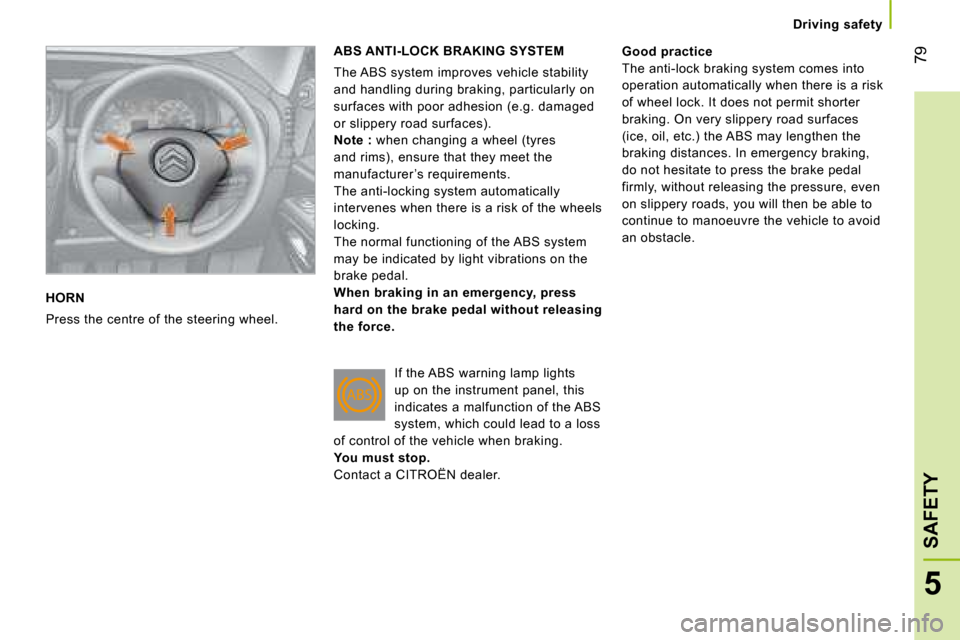
79
5
SAFETY
Driving safety
HORN
Press the centre of the steering wheel.
ABS ANTI-LOCK BRAKING SYSTEM
The ABS system improves vehicle stability
and handling during braking, particularly on
surfaces with poor adhesion (e.g. damaged
or slippery road surfaces).
Note : when changing a wheel (tyres
and rims), ensure that they meet the
manufacturer ’s requirements.
The anti-locking system automatically
intervenes when there is a risk of the wheels
locking.
The normal functioning of the ABS system
may be indicated by light vibrations on the
brake pedal.
When braking in an emergency, press
hard on the brake pedal without releasing
the force.
If the ABS warning lamp lights
up on the instrument panel, this
indicates a malfunction of the ABS
system, which could lead to a loss
of control of the vehicle when braking.
You must stop.
Contact a CITROËN dealer.
Good practice
The anti-lock braking system comes into
operation automatically when there is a risk
of wheel lock. It does not permit shorter
braking. On very slippery road surfaces
(ice, oil, etc.) the ABS may lengthen the
braking distances. In emergency braking,
do not hesitate to press the brake pedal
firmly, without releasing the pressure, even
on slippery roads, you will then be able to
continue to manoeuvre the vehicle to avoid
an obstacle.
Page 86 of 131

80
Seat belts
CAB SEAT BELTS
The front seats are fitted with pre-tensioners
and force limiters.
Fastening
Pull the strap, then insert the tongue into the
buckle.
Check that the seat belt is fastened correctly
by pulling the strap.
The lap belt must be positioned as low as
possible on the pelvis. The chest belt must
pass over the hollow of the shoulder.
Check that the seat belt is fastened correctly
by pulling the strap.
Inertia reel seat belts
These are fitted with a device which locks
automatically in the event of a collision or
emergency braking.
Safety in the event of a front impact has
been improved by the introduction of
pretensioning and force limiting seat belts.
Depending on the seriousness of the
impact, the pretensioning system instantly
tightens the seat belt against the body of the
occupant.
The pretensioning seat belts are active when
the ignition is on.
The force limiter reduces the pressure of the
seat belt against the body of the occupant in
the event of an accident.
Driver ’s seat belt not fastened warning light
When the vehicle is started, this
warning light comes on if the
driver has not fastened his seat
belt.
REAR SEAT BELTS (COMBI)
The 3-seater benchseat is fitted with 3-point
seat belts with force limiting reels.
The centre seat has a guide and a reel,
connected to the seat backrest.
When a seat belt is not in use, you
can store its buckle in the storage
space provided in the seat cushion of the
benchseat.
Page 87 of 131

81
5
SAFETY
Seat belts
Good practice
Wherever you are seated in the vehicle,
always fasten your seat belt, even for short
journeys.
The seat belts are fitted with an inertia reel
which automatically adjusts the length of the
strap to your size. The seat belt is rolled up
automatically when not in use.
Ensure that the seat belt is rolled up
correctly after use.
After folding or moving a seat, ensure that
the seat belt is rolled up correctly in its
compartment and that the buckle is ready to
accommodate the tongue. The inertia reels are fitted with a device
which automatically locks the strap in the
event of a collision or emergency braking or
if the vehicle rolls over.
The air bag warning light comes
on if the pretensioners are
triggered. Consult a CITROËN
dealer .
Depending on the nature and seriousness
of any impact, the pretensioning device may
be triggered before and independently of
inflation of the air bags. It instantly tightens
the seat belts against the body of the
occupants.
The force limiter reduces the pressure of the
seat belt against the body of the occupants.
The equipment fitted to these seat belts is
operational when the ignition is switched on. In order to be effective, a seat belt must:
- restrain one person only,
- not be twisted , check by pulling in front
of you with an even movement,
- be tightened as close to the body as possible.
The upper part of the seat belt should be
positioned in the hollow of the shoulder.
The lap part should be placed as low as
possible on the pelvis.
Do not invert the seat belt buckles as they
will not fulfil their role completely. If the
seats are fitted with armrests, the lap part of
the seat belt should always pass under the
armrest.
Check that the seat belt is fastened correctly
by pulling the strap firmly.
Recommendations for children:
- use a suitable child seat if the passenger is less than 12 years old or shorter than
one metre fifty,
- never allow a child to travel on your lap, even with the seat belt fastened.
For further information regarding child
seats, refer to the “Child safety” section
of chapter 5.
In accordance with current safety
regulations, your CITROËN dealer
guarantees all work or any checks, from
testing to maintenance, on your seat belt
equipment.
Have the seat belts checked regularly
(even after a minor impact) by a CITROËN
dealer : they must not show any signs of
wear, cutting or fraying and they must not be
transformed or modified.
Clean the seat belt straps with soapy
water or a textile cleaning product, sold
by a CITROËN dealer .
Page 99 of 131

90
Child safety
ADVICE ON CHILD SEATS
The incorrect installation of a child seat in a
vehicle compromises the child’s protection in
the event of an accident.
Remember to fasten the seat belts or the
child seat harnesses keeping the slack in
relation to the child’s body to a minimum ,
even for short journeys.
For optimum installation of the “forward
facing” child seat, ensure that the back of
the child seat is in contact with the back of
the vehicle’s seat and that the head restraint
does not cause any discomfort. Installing a booster seat
The chest part of the seat belt must be
positioned on the child’s shoulder without
touching the neck.
Ensure that the lap part of the seat belt
passes correctly over the child’s thighs.
CITROËN recommends the use of a booster
seat which has a back, fitted with a seat belt
guide at shoulder level.
As a safety precaution, do not leave:
- one or more children alone and unsupervised in a vehicle,
- a child or an animal in a vehicle which is exposed to the sun, with the windows
closed,
- the keys within reach of children inside the vehicle.
To prevent accidental opening of the doors,
use the “Child lock”.
To protect young children from the rays of
the sun, fit side blinds on the side windows.
If the head restraint has to be removed,
ensure that it is stored or attached securely
to prevent it from being thrown around the
vehicle in the event of sharp braking.
Children under the age of 10 must not travel
in the “forward facing” position on the front
passenger seat, unless the rear seats are
already occupied by other children, cannot
be used or are absent.
Disarm the passenger air bag when a “rear
facing” child seat is installed on the front
seat.
Otherwise, the child would risk being
seriously injured or killed if the air bag were
to inflate.
Page 106 of 131
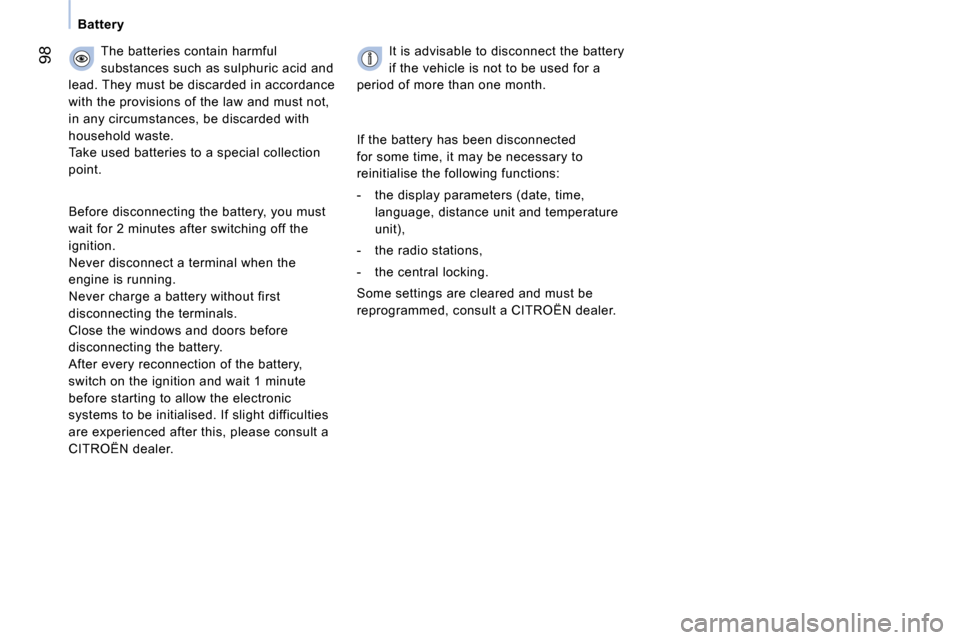
98
Battery
The batteries contain harmful
substances such as sulphuric acid and
lead. They must be discarded in accordance
with the provisions of the law and must not,
in any circumstances, be discarded with
household waste.
Take used batteries to a special collection
point.
Before disconnecting the battery, you must
wait for 2 minutes after switching off the
ignition.
Never disconnect a terminal when the
engine is running.
Never charge a battery without first
disconnecting the terminals.
Close the windows and doors before
disconnecting the battery.
After every reconnection of the battery,
switch on the ignition and wait 1 minute
before starting to allow the electronic
systems to be initialised. If slight difficulties
are experienced after this, please consult a
CITROËN dealer . It is advisable to disconnect the battery
if the vehicle is not to be used for a
period of more than one month.
If the battery has been disconnected
for some time, it may be necessary to
reinitialise the following functions:
- the display parameters (date, time, language, distance unit and temperature
unit),
- the radio stations,
- the central locking.
Some settings are cleared and must be
reprogrammed, consult a CITROËN dealer .
Page 108 of 131
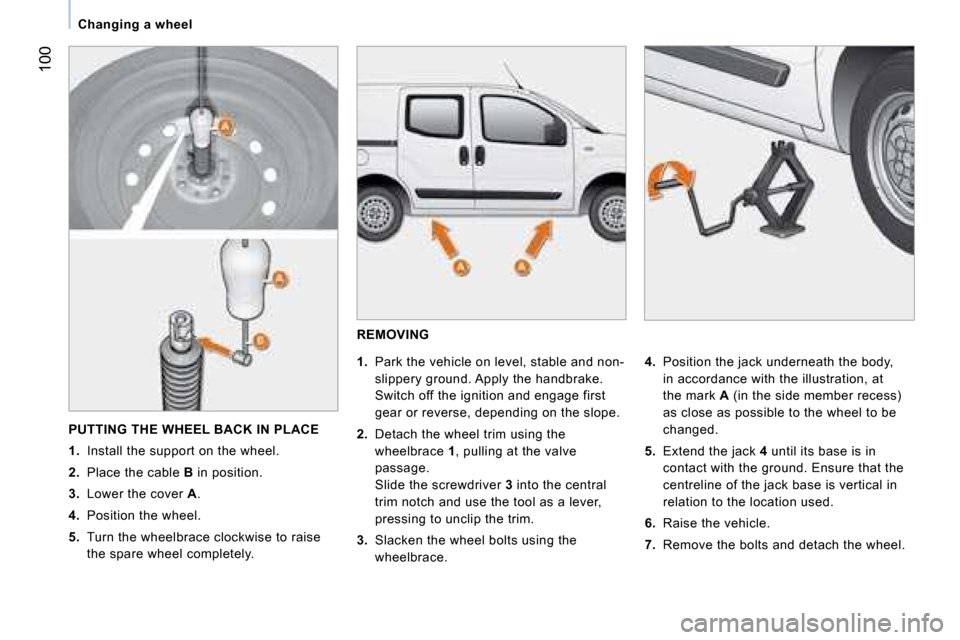
100
Changing a wheel
REMOVING
1. Park the vehicle on level, stable and non-
slippery ground. Apply the handbrake.
Switch off the ignition and engage first
gear or reverse, depending on the slope.
2.
Detach the wheel trim using the
wheelbrace 1, pulling at the valve
passage.
Slide the screwdriver 3 into the central
trim notch and use the tool as a lever,
pressing to unclip the trim.
3. Slacken the wheel bolts using the
wheelbrace.
4. Position the jack underneath the body,
in accordance with the illustration, at
the mark A (in the side member recess)
as close as possible to the wheel to be
changed.
5. Extend the jack 4 until its base is in
contact with the ground. Ensure that the
centreline of the jack base is vertical in
relation to the location used.
6. Raise the vehicle.
7. Remove the bolts and detach the wheel.
PUTTING THE WHEEL BACK IN PLACE
1. Install the support on the wheel.
2. Place the cable B in position.
3. Lower the cover A .
4. Position the wheel.
5. Turn the wheelbrace clockwise to raise
the spare wheel completely.
Page 112 of 131
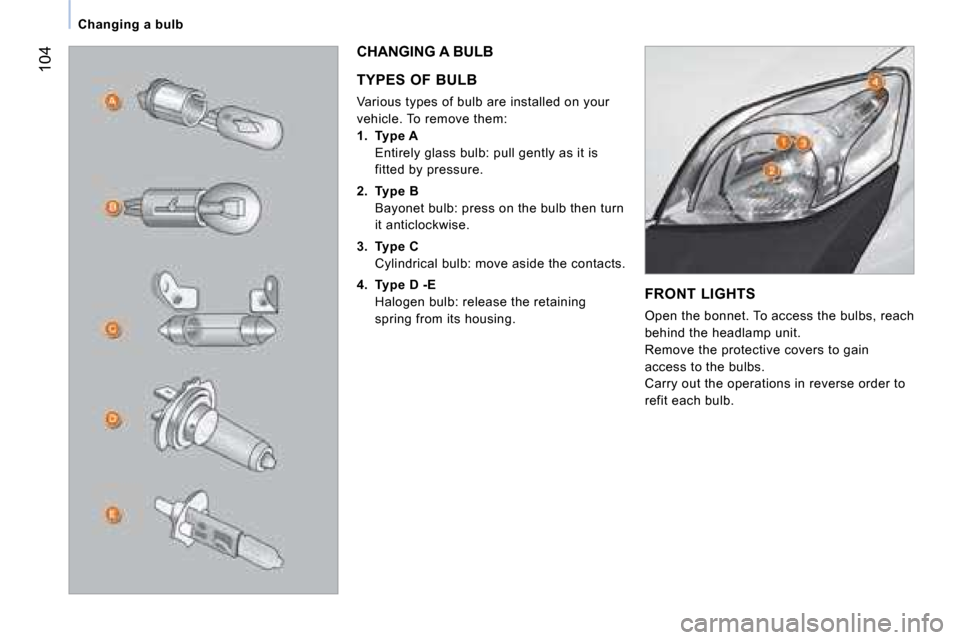
104
Changing a bulb
FRONT LIGHTS
Open the bonnet. To access the bulbs, reach
behind the headlamp unit.
Remove the protective covers to gain
access to the bulbs.
Carry out the operations in reverse order to
refit each bulb.
CHANGING A BULB
TYPES OF BULB
Various types of bulb are installed on your
vehicle. To remove them:
1. Type A
Entirely glass bulb: pull gently as it is
fitted by pressure.
2. Type B
Bayonet bulb: press on the bulb then turn
it anticlockwise.
3. Type C
Cylindrical bulb: move aside the contacts.
4. Type D -E
Halogen bulb: release the retaining
spring from its housing.
Page 113 of 131
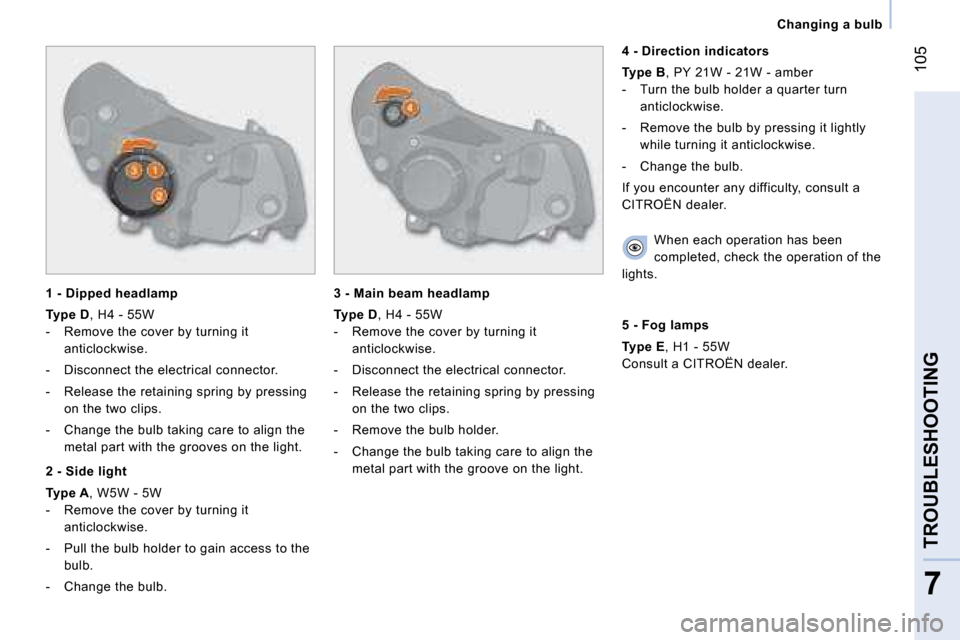
105
7
TROUBLESHOOTING
Changing a bulb
1 - Dipped headlamp
Type D , H4 - 55W
- Remove the cover by turning it anticlockwise.
- Disconnect the electrical connector.
- Release the retaining spring by pressing on the two clips.
- Change the bulb taking care to align the metal part with the grooves on the light.
2 - Side light
Type A , W5W - 5W
- Remove the cover by turning it anticlockwise.
- Pull the bulb holder to gain access to the bulb.
- Change the bulb.
3 - Main beam headlamp
Type D , H4 - 55W
- Remove the cover by turning it anticlockwise.
- Disconnect the electrical connector.
- Release the retaining spring by pressing on the two clips.
- Remove the bulb holder.
- Change the bulb taking care to align the metal part with the groove on the light.
4 - Direction indicators
Type B , PY 21W - 21W - amber
- Turn the bulb holder a quarter turn anticlockwise.
- Remove the bulb by pressing it lightly while turning it anticlockwise.
- Change the bulb.
If you encounter any difficulty, consult a
CITROËN dealer.
When each operation has been
completed, check the operation of the
lights.
5 - Fog lamps
Type E , H1 - 55W
Consult a CITROËN dealer .
Page 120 of 131
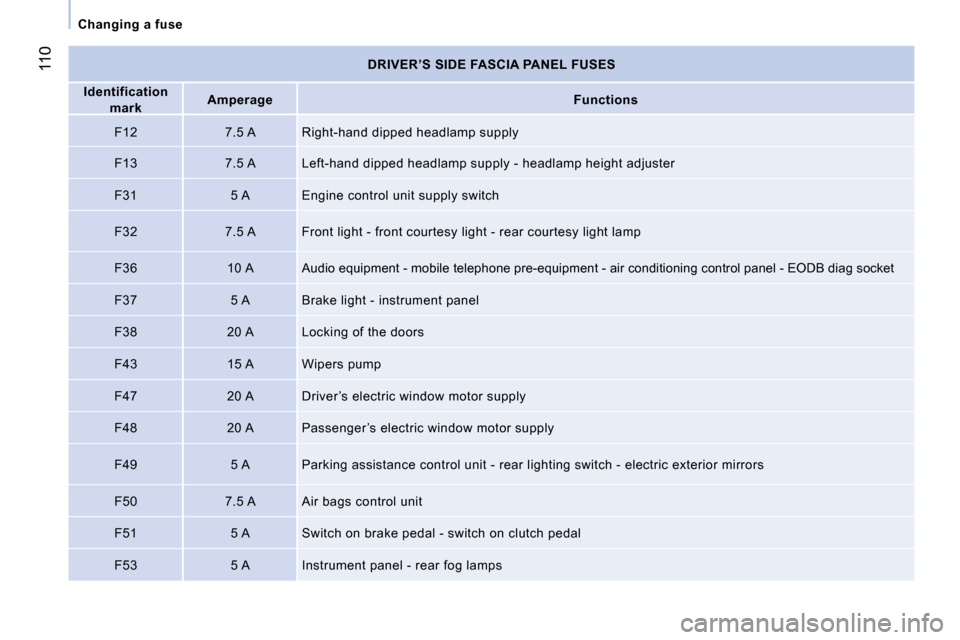
110
Changing a fuse
Identification
mark
Amperage
Functions
F12 7.5 A Right-hand dipped headlamp supply
F13 7.5 A Left-hand dipped headlamp supply - hea dlamp height adjuster
F31 5 A Engine control unit supply switch
F32 7.5 A Front light - front courtesy light - r ear courtesy light lamp
F36 10 A Audio equipment - mobile telephone pre- equipment - air conditioning control panel - EODB diag socket
F37 5 A Brake light - instrument panel
F38 20 A Locking of the doors
F43 15 A Wipers pump
F47 20 A Driver ’s electric window motor supply
F48 20 A Passenger ’s electric window motor suppl y
F49 5 A Parking assistance control unit - rear l ighting switch - electric exterior mirrors
F50 7.5 A Air bags control unit
F51 5 A Switch on brake pedal - switch on clutch pedal
F53 5 A Instrument panel - rear fog lamps DRIVER’S SIDE FASCIA PANEL FUSES
Page 122 of 131
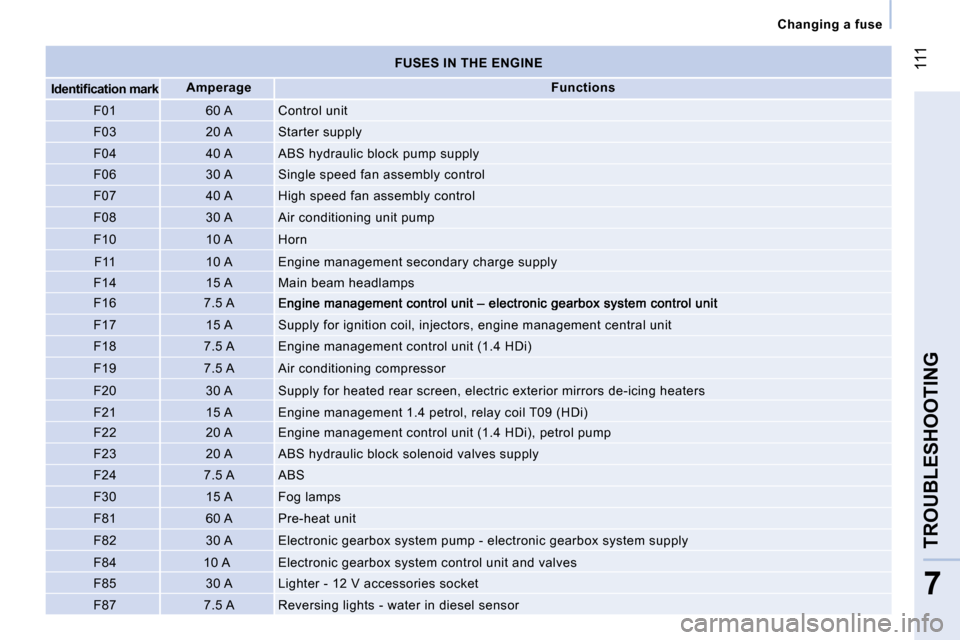
111
7
TROUBLESHOOTING
Changing a fuse
�I�d�e�n�t�i�fi� �c�a�t�i�o�n� �m�a�r�k
Amperage
Functions
F01 60 A Control unit
F03 20 A Starter supply
F04 40 A ABS hydraulic block pump supply
F06 30 A Single speed fan assembly control
F07 40 A High speed fan assembly control
F08 30 A Air conditioning unit pump
F10 10 A Horn F11 10 A Engine management secondary charge supp ly
F14 15 A Main beam headlamps
F16 7.5 A
F17 15 A Supply for ignition coil, injectors, en gine management central unit
F18 7.5 A Engine management control unit (1.4 HD i)
F19 7.5 A Air conditioning compressor
F20 30 A Supply for heated rear screen, electric exterior mirrors de-icing heaters
F21 15 A Engine management 1.4 petrol, relay coi l T09 (HDi)
F22 20 A Engine management control unit (1.4 HDi ), petrol pump
F23 20 A ABS hydraulic block solenoid valves sup ply
F24 7.5 A ABS
F30 15 A Fog lamps
F81 60 A Pre-heat unit
F82 30 A
Electronic gearbox system pump - electronic gearbo x system supply
F84 10 A Electronic gearbox system control unit and valves
F85 30 A Lighter - 12 V accessories socket
F87 7.5 A Reversing lights - water in diesel sen sor
FUSES IN THE ENGINE